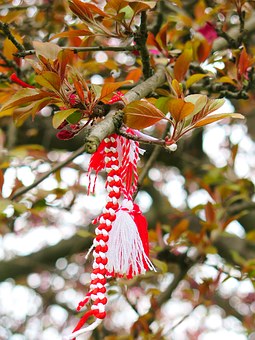Thessaloniki gets ready for its metro launch in November
The underground rapid transit lines have been under construction for almost two decades due to various project delays
 TheMayor.EU logo
TheMayor.EU logo Ancient symbols of spring, health, peace and fertility
For most people in Europe, the arrival of March also means the end of winter, spring cleaning and spending more time outdoors. On the Balkans, this month has held a special meaning for the local people since times immemorial.
On 1 March, the Day of “Grannie Marta” (Baba Marta), Bulgarians decorate themselves with a martenitsa - a small piece of adornment, made of white and red yarn. This tradition marks one of the most Bulgarian customs and it dictates that the wearer should take off the martenitsa when they see a blossoming tree or a stork
The white color symbolizes beauty, purity, innocence and joy. The red one is the color of vitality, health and love, victory, life and courage, the light of a rising or a setting sun.
This color according to popular belief, has the power of the sun and gives vitality to every creature. At the end of March you can see many trees adorned with red and white bracelets in Bulgaria. That likely means that this was the first tree in blossom that the people passing by encountered during the season.

Greek ethnologists connect this custom with the ancient pagan history of the Balkan Peninsula, especially with the agricultural fertility cults. Martenitsas (μάρτης) in Greece are preserved only in the high mountain areas far from major urban and cultural centers.
In Greek villages grandmothers tie martenitsas to small children’s hands so that they will be healthy and happy all year long. In general, this custom has been forgotten in the big cities, but around the Universities and the places where young people gather, you can see smiling boys and girls with red and white bracelets around their wrists.
Martenitsa (mărțișor) is an ancient symbol representing the revival of nature on the cusp of spring. This custom, according to tradition, is related to the time of symbolic death and symbolic birth of a local female deity – Baba Dokiya. Martsashor is also the name for the month of March in Romanian language.
Source: Wikipedia

The underground rapid transit lines have been under construction for almost two decades due to various project delays

Now you can get your wine in Talence by paying directly in Bitcoin

That’s because the state has to spend money on updating the railway infrastructure rather than subsidizing the cost of the popular pass

Rethinking renewable energy sources for the urban landscape

The examples, compiled by Beyond Fossil Fuels, can inform and inspire communities and entrepreneurs that still feel trepidation at the prospect of energy transition

Now you can get your wine in Talence by paying directly in Bitcoin

The 10th European Conference on Sustainable Cities and Towns (ESCT) sets the stage for stronger cooperation between the EU, national and local level to fast track Europe's transition to climate neutrality.

At least, that’s the promise made by the mayor of Paris, Anne Hidalgo

The underground rapid transit lines have been under construction for almost two decades due to various project delays

At least, that’s the promise made by the mayor of Paris, Anne Hidalgo

Hostal de Pinós is located in the geographical centre of the autonomous region

Despite its church-y name, the district has long been known as the hangout spot for the artsy crowds

Urban dwellers across the EU are having a say in making their surroundings friendlier to people and the environment.

Forests in the EU can help green the European construction industry and bolster a continent-wide push for architectural improvements.

Apply by 10 November and do your part for the transformation of European public spaces

An interview with the Mayor of a Polish city that seeks to reinvent itself

An interview with the newly elected ICLEI President and Mayor of Malmö

A conversation with the Mayor of Lisbon about the spirit and dimensions of innovation present in the Portuguese capital














